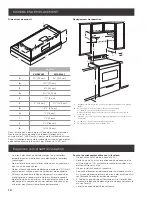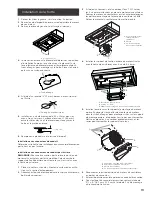
5
LOCATION REQUIREMENTS
Product dimensions
E
F
B
K
A
C
G
H
I
J
D
Models
EMD530S3
EMD536S3
A
30” (76 cm)
36” (91.2 cm)
B
19
5
⁄
8
” (50 cm)
C
9
3
⁄
4
” (25 cm)
D
23⁄16” (5.5 cm)
E
1
10
⁄
16
” (4 cm)
F
3” (7.6 cm)
53/4” (14.6 cm)
G
13
13
⁄
16
” (35 cm)
H
5
⁄
8
” (1.6 cm)
I
1
3
⁄
16
” (3 cm)
J
7
1
⁄
4
” (18.4 cm)
K
12” (30.5 cm)
For gas range installation: Mount this hood so that the bottom
edge is at minimum 27”(68.6 cm) above the cooking surface.
For electric range installation: mount this hood so that the
bottom is not less than 24”(61 cm).
Installation clearances
C
B
D
E
A
A. 18” (45.7 cm) min. clearance - upper cabinet to countertop
B. 24” (61 cm) min. for electric cooking surfaces
27” (68.6 cm) min. for gas cooking surfaces
36” (91.4 cm) suggested max. - bottom of range hood to cooking surface
C. 30” or 36” (76.2 cm or 91.4 cm) min. cabinet opening width
D. 12” (30.5 cm) cabinet depth
E. 36” (91.4 cm) base cabinet height
Ducting Options
• Vent system must terminate to the outdoors, except for no
vented (recirculating) installations.
• Do not terminate the vent system in an attic or other
enclosed area.
• Do not use a 4” (10.2 cm) laundry-type wall cap.
• Rigid metal vent is recommended. Plastic or metal foil
vent is not recommended. The length of vent system and
number of elbows should be kept to a minimum to provide
efficient performance.
For the most efficient and quiet operation:
• Use no more than three 90° elbows.
• Make sure there is a minimum of 24” (61 cm) of straight
vent between the elbows if more than 1 elbow is used.
• Do not install 2 elbows together.
• Use clamps to seal all joints in the vent system.
• The vent system must have a damper.
• Use caulking to seal exterior wall or roof opening around
the cap.
• The size of the vent should be uniform.






































